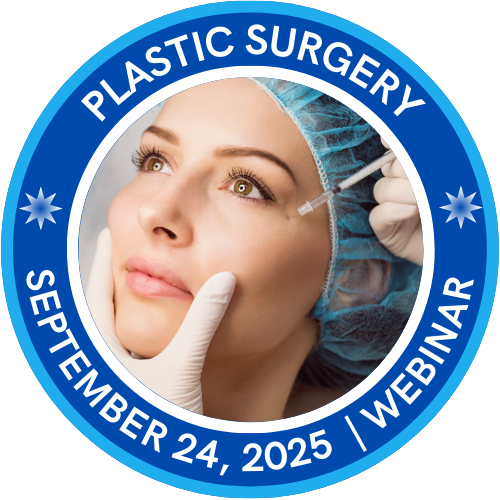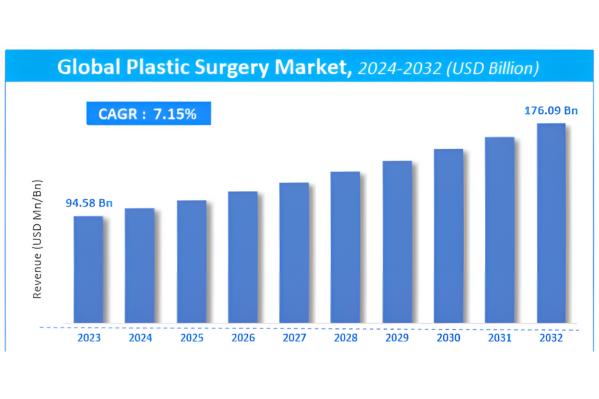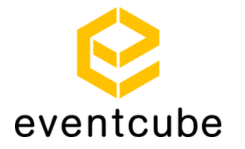"The Next Frontier in Aesthetic Medicine"
Welcome to the Webinar on in Plastic Surgery, scheduled to be held on September 24, 2025, through Online mode. It is an honor to welcome such a distinguished gathering of surgeons, medical professionals, researchers, and students who share a deep commitment to the art and science of plastic surgery. This webinar serves as a dynamic platform to explore the latest innovations, surgical techniques, and transformative applications in both reconstructive and aesthetic surgery. From restoring function and form to enhancing confidence and quality of life, plastic surgery continues to evolve with technology and clinical excellence. We are privileged to host esteemed speakers who will share their expertise and experience, sparking meaningful discussions and future collaborations. I encourage all participants to actively engage, ask questions, and take full advantage of this enriching learning opportunity.
Plastic surgery is a specialized branch of medicine that focuses on the restoration, reconstruction, and enhancement of the human body. It is broadly divided into two main categories: reconstructive surgery and cosmetic (aesthetic) surgery. Reconstructive surgery aims to correct physical defects caused by birth disorders, trauma, burns, or disease, helping patients regain normal function and appearance. Cosmetic surgery, on the other hand, is performed to enhance a person’s appearance and boost self-confidence through procedures such as rhinoplasty, facelifts, and body contouring. Plastic surgeons combine medical expertise with artistic skill to achieve natural-looking results while prioritizing patient safety and well-being. Advances in technology and surgical techniques continue to expand the possibilities within this dynamic and impactful field.

Minimally invasive procedures are advanced surgical techniques that allow physicians to perform operations with smaller incisions, less tissue damage, and faster recovery times compared to traditional open surgery. These procedures often utilize laparoscopic tools, endoscopes, lasers, or robotic systems to access internal structures with high precision. In plastic and cosmetic surgery, minimally invasive techniques are widely used for treatments such as Botox injections, dermal fillers, liposuction, laser resurfacing, and endoscopic facelifts. The benefits include reduced scarring, lower risk of complications, shorter hospital stays, and a quicker return to daily activities. As technology continues to advance, minimally invasive methods are expanding into more complex surgical fields, improving patient outcomes and satisfaction. Their growing popularity underscores a shift toward safer, more efficient, and cosmetically appealing medical solutions.
Non-surgical aesthetic treatments are cosmetic procedures that enhance appearance without the need for invasive surgery, offering patients subtle and natural-looking results with minimal downtime. These treatments have gained immense popularity due to their convenience, safety, and quick recovery times. Common non-surgical options include Botox injections, dermal fillers, chemical peels, laser skin resurfacing, microdermabrasion, microneedling, and non-invasive body contouring technologies like cryolipolysis and ultrasound therapy. These procedures are often used to reduce wrinkles, improve skin texture, restore facial volume, and sculpt the body. Ideal for patients seeking anti-aging solutions or minor enhancements, non-surgical treatments provide flexibility and are often performed in outpatient settings. As technology and techniques continue to evolve, non-surgical aesthetic medicine is becoming a cornerstone of modern cosmetic care, offering effective, low-risk alternatives to traditional plastic surgery.
Facial rejuvenation refers to a range of cosmetic treatments designed to restore a youthful appearance by addressing signs of aging such as wrinkles, sagging skin, uneven tone, and volume loss. These procedures can be surgical (like facelifts, brow lifts, or eyelid surgery) or non-surgical, including Botox, dermal fillers, laser resurfacing, chemical peels, and microneedling. The goal of facial rejuvenation is not just to reverse aging but to enhance natural features while maintaining harmony and balance in the facial structure. With advancements in aesthetic technology and minimally invasive techniques, personalized treatment plans can be tailored to suit individual needs and expectations. Facial rejuvenation continues to grow in popularity as patients seek effective, long-lasting, and natural-looking results with minimal downtime.
Body contouring encompasses a variety of cosmetic procedures aimed at reshaping and improving the appearance of the body by removing excess fat, tightening skin, and enhancing overall body proportions. It includes both surgical options such as liposuction, tummy tucks (abdominoplasty), and body lifts, as well as non-surgical techniques like cryolipolysis (fat freezing), radiofrequency treatments, and laser lipolysis. Body contouring is often sought after significant weight loss, aging, or post-pregnancy changes, helping individuals achieve a more toned, defined, and confident look. These procedures are highly customizable, allowing patients to target specific areas such as the abdomen, thighs, arms, buttocks, and neck. With continuous advancements in technology, modern body contouring methods offer safer, less invasive options with reduced recovery time and highly satisfying outcomes.
Regenerative medicine is a rapidly advancing field that focuses on repairing, replacing, or regenerating damaged tissues and organs using the body’s own healing mechanisms. It combines principles from cell biology, tissue engineering, and molecular biology to develop innovative therapies that restore function in ways traditional medicine cannot. In plastic and reconstructive surgery, regenerative medicine is revolutionizing treatments through the use of stem cells, platelet-rich plasma (PRP), fat grafting, and biomaterials to promote natural tissue regeneration and enhance healing. These techniques are being used to improve skin quality, accelerate wound healing, and restore volume and structure in aesthetic and reconstructive procedures. As research progresses, regenerative medicine holds tremendous promise for minimally invasive, long-lasting solutions that not only treat symptoms but address the root causes of tissue damage.
Laser skin resurfacing is a popular dermatological and cosmetic procedure that uses concentrated beams of light to improve skin texture, tone, and appearance. By precisely removing damaged outer layers of skin, it stimulates collagen production and encourages the growth of new, healthier skin. Laser resurfacing is highly effective in treating wrinkles, fine lines, acne scars, sun damage, pigmentation issues, and uneven skin tone. There are two main types of lasers used: ablative lasers, which remove skin layers for more dramatic results, and non-ablative lasers, which work deeper in the skin to promote healing with minimal downtime. Advances in laser technology have made the procedure safer, more customizable, and suitable for a wider range of skin types. With proper care, laser skin resurfacing offers long-lasting, rejuvenating effects, making it a key option in non-surgical aesthetic treatments.
Fat grafting, also known as fat transfer or autologous fat transplantation, is a cosmetic and reconstructive procedure that involves harvesting fat from one area of the body—typically the abdomen, thighs, or flanks—and injecting it into another area to restore volume, contour, or enhance appearance. This technique is widely used in facial rejuvenation, breast and buttock augmentation, and correcting contour deformities. Because the fat comes from the patient’s own body, it is biocompatible and carries a lower risk of allergic reactions or rejection. In addition to its aesthetic benefits, fat grafting also provides regenerative effects due to the presence of stem cells in the fat, which can improve skin quality and healing. As a minimally invasive alternative to synthetic fillers or implants, fat transfer offers natural-looking, long-lasting results with the dual benefit of body contouring in the donor site.
Plastic surgery tourism is a growing global trend where individuals travel abroad to undergo cosmetic or reconstructive procedures, often motivated by lower costs, shorter wait times, and access to specialized expertise. Popular destinations include countries like South Korea, Brazil, Turkey, Thailand, and Mexico, which are known for their advanced medical facilities and skilled plastic surgeons. Patients typically combine their procedures with vacation experiences, making the journey both medical and recreational. While plastic surgery tourism offers financial and aesthetic advantages, it also raises concerns about post-operative care, follow-up, legal protections, and communication barriers. To ensure safety, it is crucial for patients to thoroughly research credentials, facility accreditations, and aftercare support before committing to a procedure abroad. As the industry continues to expand, global standards and patient education are key to making plastic surgery tourism a safe and rewarding option.
Artificial Intelligence (AI) in plastic surgery is revolutionizing the way cosmetic and reconstructive procedures are planned, performed, and evaluated. AI-powered tools such as 3D imaging, facial recognition, and predictive modeling enable surgeons to visualize outcomes, simulate procedures, and personalize treatment plans with greater accuracy than ever before. These technologies enhance pre-operative planning, help identify ideal proportions based on patient-specific anatomy, and even assist during surgery through robotic guidance and precision mapping. AI also plays a vital role in patient consultations, offering virtual previews of results and aiding in better decision-making. Moreover, AI-driven data analysis improves post-operative care by predicting complications and tracking recovery trends. As AI continues to evolve, it is poised to increase efficiency, safety, and patient satisfaction, making it an indispensable tool in the future of plastic surgery.
Tummy tuck, medically known as abdominoplasty, is a surgical procedure designed to remove excess skin and fat from the abdominal area while tightening the underlying muscles to create a flatter, firmer, and more contoured midsection. Often sought after pregnancy, significant weight loss, or aging, this procedure addresses loose or sagging skin and diastasis recti (muscle separation), which cannot be corrected through diet and exercise alone. There are several variations, including full, mini, and extended tummy tucks, depending on the extent of correction needed. While not a substitute for weight loss, a tummy tuck can significantly enhance body shape and boost self-confidence. With advancements in surgical techniques and post-operative care, abdominoplasty today offers more natural-looking results, reduced scarring, and faster recovery, making it a popular choice in both cosmetic and reconstructive plastic surgery.
Gender affirmation surgery (also known as gender confirmation or gender reassignment surgery) refers to a range of surgical procedures that help align an individual’s physical appearance and anatomy with their gender identity. These surgeries are a vital part of gender-affirming care for many transgender and non-binary individuals, contributing significantly to mental health, self-esteem, and overall well-being. Common procedures include top surgery (breast augmentation or mastectomy), bottom surgery (such as vaginoplasty, phalloplasty, or metoidioplasty), and facial feminization or masculinization surgery. Gender affirmation surgeries are typically performed by highly trained plastic or reconstructive surgeons and are often supported by multidisciplinary teams including endocrinologists, psychologists, and primary care providers. As awareness and acceptance grow, these procedures are becoming more accessible, supported by advances in surgical techniques and a deeper understanding of their importance in affirming gender identity and enhancing quality of life.
Non-surgical rhinoplasty, also known as a liquid nose job, is a minimally invasive cosmetic procedure that reshapes and enhances the nose using injectable dermal fillers rather than surgery. It is ideal for individuals looking to smooth out bumps, lift the nasal tip, or improve symmetry without the downtime and risks associated with traditional rhinoplasty. The procedure typically involves hyaluronic acid-based fillers, and results are visible immediately, often lasting 6 to 18 months depending on the product used. Non-surgical rhinoplasty is performed in-office and usually takes less than 30 minutes, with minimal discomfort and recovery time. While it cannot reduce nose size or address functional issues like breathing problems, it offers a quick, effective, and reversible option for subtle aesthetic improvements. This procedure has gained popularity for its safety, precision, and convenience, especially among those seeking temporary changes or exploring options before committing to surgery.
Craniofacial and maxillofacial surgery is a specialized field of plastic and reconstructive surgery focused on the correction of congenital and acquired deformities of the skull, face, jaw, and neck. These procedures address a wide range of complex conditions, including cleft lip and palate, craniosynostosis, facial trauma, jaw misalignment, tumors, and birth anomalies. Performed by highly trained surgeons, these surgeries not only restore aesthetic appearance but also significantly improve functional outcomes such as speech, breathing, chewing, and vision. The field combines advanced surgical techniques, including 3D imaging, computer-aided planning, and custom implants, to ensure precise and personalized treatment. Craniofacial and maxillofacial surgery plays a crucial role in both pediatric and adult care, offering life-changing results that enhance physical function, psychological well-being, and social integration.
Plastic surgery practice management involves the strategic and operational oversight required to run a successful plastic surgery clinic or practice. This includes patient relations, staff coordination, financial planning, regulatory compliance, marketing, and the integration of digital tools and technologies. Efficient practice management ensures not only the smooth day-to-day functioning of the clinic but also enhances patient satisfaction, retention, and overall profitability. With the rise of aesthetic medicine and elective procedures, managing brand presence—both online and offline—has become essential. Tools such as electronic medical records (EMR), telehealth platforms, and CRM systems help streamline operations, while targeted marketing and reputation management are key to attracting and retaining clients in a competitive market. A well-managed practice empowers surgeons to focus on patient care while maintaining high standards of efficiency, ethics, and excellence.
Hand surgery and microsurgery are specialized areas within plastic and reconstructive surgery that focus on the restoration of function, appearance, and sensation in the hands, fingers, and upper extremities. These procedures address a variety of conditions, including traumatic injuries, congenital deformities, nerve damage, tendon injuries, arthritis, and carpal tunnel syndrome. Microsurgery involves the use of high-powered magnification and precision instruments to perform intricate repairs on tiny blood vessels, nerves, and tissues, often essential for replantation of severed limbs, free tissue transfers, and complex reconstructive procedures. Hand and microsurgical techniques require a deep understanding of anatomy and exceptional surgical skill, as the goal is to restore fine motor abilities and improve quality of life. With advances in technology, including robotic assistance and 3D imaging, these fields continue to evolve, offering highly successful outcomes even in the most challenging cases.
Aesthetic surgery, also known as cosmetic surgery, focuses on enhancing an individual’s appearance through surgical and non-surgical procedures that improve symmetry, proportion, and overall visual appeal. Unlike reconstructive surgery, which restores function or form due to trauma or medical conditions, aesthetic surgery is elective and primarily performed for personal enhancement and confidence. Common procedures include facelifts, rhinoplasty, liposuction, breast augmentation, eyelid surgery, and body contouring, among others. With advances in surgical techniques, anesthesia, and minimally invasive options, aesthetic surgery now offers more natural-looking results, reduced recovery times, and greater safety. Increasingly popular worldwide, this field continues to evolve, integrating technology, patient-centered care, and innovation to meet the growing demand for personalized beauty standards and improved self-image.
Our webinars are thoughtfully designed to deliver value to a wide range of individuals. Whether you're looking to grow your skills, explore new opportunities or gain insights from experts, here's who will benefit most from attending:
If you're aiming to advance in your career or stay updated with the latest trends in your field, this webinar is perfect for you. Gain actionable insights and learn from industry experts.
Professors, scholars, and students presenting findings or exploring the latest research in their field and individuals looking for collaboration opportunities.
Discover strategies, tools, and techniques to scale your business, enhance productivity, and achieve your goals. This is your chance to learn from real-world success stories.
Are you curious about new concepts or looking to bridge the gap between academia and industry? Our webinars provide practical knowledge that goes beyond textbooks.
Stay ahead of the curve! If you're passionate about the topic and want to understand the latest innovations, trends, or developments, you'll find immense value here.
In a world where knowledge is power, webinars have emerged as one of the most accessible and impactful ways to learn, grow and connect. Don't miss the chance to learn, grow and connect in ways that truly matter.
Webinars are often hosted by industry experts, thought leaders, and innovators. Attending gives you direct access to their insights, strategies, and expertise that you can immediately apply in your personal or professional life.
The digital world evolves rapidly. Webinars provide up-to-date information on the latest trends, tools, and techniques, ensuring you stay ahead of the curve in your industry or area of interest.
Webinars aren't just passive presentations they're dynamic and interactive. Participate in live Q&A sessions, answer polls, and share your thoughts with like-minded participants.
Webinars connect you with professionals, experts, and enthusiasts from around the globe. It's a unique opportunity to grow your network and collaborate with others who share your interests.
Many webinars are free or available at a fraction of the cost of in-person events. This makes them an affordable way to learn from experts without incurring travel or accommodation expenses.
Webinars often include access to resources such as presentation slides, e-books and recordings. These materials ensure you can revisit the content and reinforce your learning anytime.
A great webinar can spark new ideas and reinvigorate your passion for a topic. The insights you gain may open new opportunities or provide the push you need to achieve your goals.
Webinars are designed with specific audiences in mind. Whether you're seeking professional development, personal growth, or technical know-how, you're likely to find a webinar that suits your interests perfectly.
Stay ahead of the curve! If you're passionate about the topic and want to understand the latest innovations, trends, or developments, you'll find immense value here.
Best platform for Global business and Networking opportunities B2B Meetings Poster Sessions on every career stage Networking Opportunities
Registering for a webinar is essential to gain access to the unique opportunities and secure a chance to grow, connect and gain insights that can drive your personal and professional success. Webinars are more than just online meetings, they're gateways to knowledge, innovation, and growth.

The global plastic surgery market is witnessing remarkable growth, driven by increasing demand for both reconstructive and cosmetic procedures. Valued at approximately USD 88.9 billion in 2024, the market is projected to reach USD 204.9 billion by 2033, growing at a CAGR of 9.23%. Key factors contributing to this expansion include technological advancements such as 3D printing, minimally invasive techniques, and the integration of AI in surgical planning. There is also a growing trend toward natural-looking enhancements and regenerative treatments like fat grafting and platelet-rich plasma (PRP) therapy. Regions like North America dominate the market due to advanced healthcare infrastructure and high procedural volumes, while emerging economies are showing increasing interest as awareness and affordability rise. Additionally, male aesthetic procedures and post-weight-loss body contouring are becoming more popular, further diversifying the patient base. As the field continues to evolve, plastic surgery is poised to remain a dynamic and high-growth segment in global healthcare.





